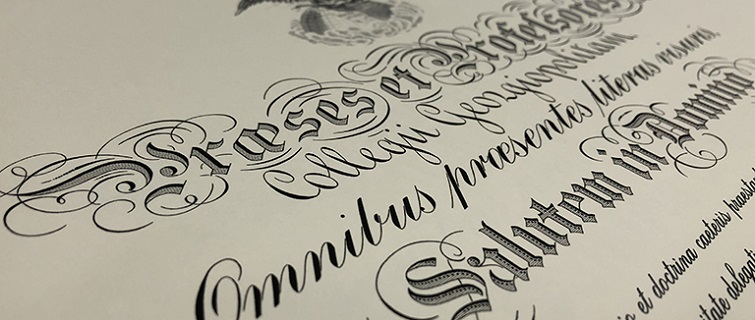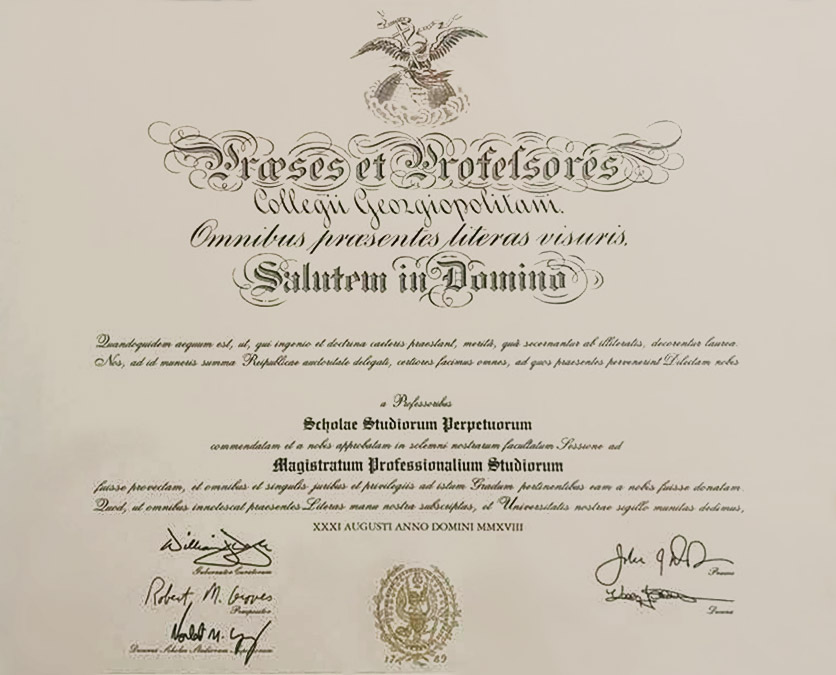
Students pursuing online master’s degrees through Georgetown’s School of Continuing Studies sometimes ask if their diplomas will look the same as those earned by students attending traditional classes.
The simple answer is, “yes.” They will look the same. Indeed, they are the same.
“There is no distinction according to the mode of instruction for degrees awarded on the Georgetown transcript,” said John Q. Pierce, former University Registrar, who retired from that post in 2016 after 32 years and now serves as Special Assistant to the Provost. “Following from that, there is no distinction on the diploma—the basic text of the diploma is the same for all Georgetown students.”
In other words, the diploma looks the same and conveys the same message whether the degree was earned at Georgetown College, the School of Continuing Studies, the McDonough School of Business, Georgetown University School of Medicine, or any of the other schools in a university serving about 7,500 undergraduate and 12,000 graduate and professional students. The only things that vary are the nature of the degree, the name of the Georgetown school, the officials who sign the diploma, and the name of the person receiving it. All Georgetown diplomas are written in Latin because of Latin’s place in academic and ecclesiastical history and tradition.
A Congressionally Chartered University
Why this consistency across all of Georgetown’s schools and programs? The reasons go beyond mere clarity and convenience. The diploma is a symbolic document that reflects not only the accomplishments of the individual, but the unifying vision of the University as well.
Founded in 1789, the first Catholic and Jesuit institution in the country is premised on a set of values, a way of regarding the world and one’s place in it that is unique to the 450-year-old tradition of Jesuit education. Georgetown is also the first of only five universities to be Congressionally chartered, its charter having been signed into law in 1815 by President James Madison.
At the bottom of the diploma is the University’s seal and, in its center, an eagle, reminiscent of the Great Seal of the United States of America. But instead of clutching arrows and an olive branch, as is the case on the U.S. seal, Georgetown’s eagle holds an orb, signifying the world and the knowledge to be acquired there, and the Latin cross, symbolizing the Jesuit values that inform all aspects of university life. Rather than E. Pluribus Unum (“out of many, one'') the Georgetown motto, Utraque Unum, translates from the Latin as “both into one,” a fusing of scholarship and spiritual growth that undergirds a Jesuit education.
“Georgetown is the oldest Catholic and Jesuit university in the United States—and if you know anything about Georgetown, you know how much we pride ourselves on our Jesuit values and religious origins,” a student at Georgetown College wrote in a 2016 blog on the University’s website. “Yet, despite its strong Catholic and Jesuit background, Georgetown is also deeply committed to its interfaith identity, and this is something I had no idea about before coming to Georgetown!”
The ‘Spirit of Georgetown’
Indeed, “Interreligious Understanding” and “Community in Diversity” are two of the 10 tenants that characterize the Spirit of Georgetown, a list of values and characteristics referenced in the University’s mission statement, institutional documents, and iconography.
Read that compendium—with its exhortations to care for others, do justice, protect the vulnerable, and promote the common good—and it becomes clear that the Georgetown diploma is more than a recognition of academic achievement (although it is certainly that). It is an implicit call to use that knowledge in service to the world.
